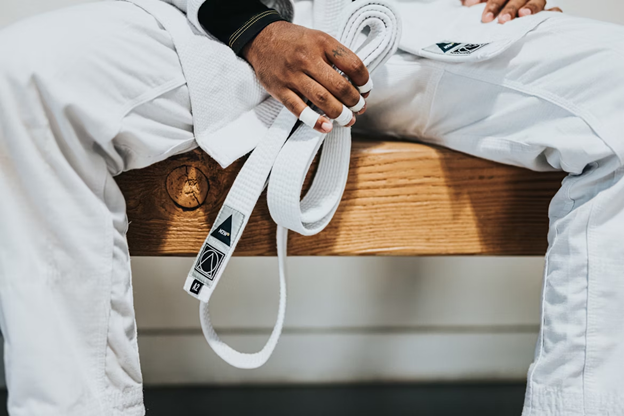
https://unsplash.com/photos/person-in-white-dress-shirt-holding-white-plastic-bag-2aKCSVCkX0o
Starting martial arts?
Here’s the thing…
Getting the right gear can make or break your training. With 40% of martial arts participants being under 18, millions of new people are jumping into martial arts every year.
And they’re making the same mistakes.
They buy cheap gear. They skip the essentials. They end up injured or frustrated.
Don’t be one of them.
The wrong equipment won’t just slow your progress — it’ll put you on the sidelines with injuries that could have been avoided.
What you’ll discover:
- Must-Have Protective Gear for Safe Training
- Essential Training Equipment That Works
- Smart Shopping Tips to Maximize Your Budget
- Maintaining Your Gear for Maximum Lifespan
Why Quality Gear Actually Matters
Want to know something most beginners get wrong?
They think gear is just about looking good.
Wrong.
With 18 million Americans participating in martial arts every year, the demand for quality equipment has exploded. The martial arts equipment market hit $1.39 billion in 2024.
Here’s why that matters:
Quality gear protects you. It improves your performance. Most importantly — it gives you confidence to train harder.
When you invest in premium martial arts supplies, you’re investing in your success. Cheap gear breaks. Quality gear lasts.
Think about it:
Great martial artists train consistently. And consistent training requires equipment that won’t let you down when you need it most.
It really is that simple.
Protective Gear: Don’t Skip These
Let’s start with the non-negotiables.
Hand Protection
Your hands are everything in martial arts.
Hand wraps and gloves aren’t optional. They’re requirements if you want to train without breaking bones.
Hand wraps do two things:
- Support your wrists during strikes
- Protect small hand bones from fractures
Get 180-inch cotton blend wraps. They breathe. They support. They work.
Avoid synthetic materials that trap sweat and smell terrible.
For gloves, look for:
- Adequate knuckle padding
- Secure wrist closure
- Proper ventilation
- Quality leather construction
Pro tip: Don’t go cheap on gloves. Your hands will thank you later.
Head Protection
Headgear might not look cool…
But brain injuries aren’t cool.
Modern headgear has gotten much better. No more bulky, vision-blocking designs. Today’s options protect without limiting what you can see or hear.
Essential headgear features:
- Impact-absorbing foam padding
- Adjustable chin strap
- Clear sight lines
- Lightweight construction
Bottom line: Protect your head. You only get one brain.
Shin Guards and Foot Protection
Training with kicks?
Shin-on-shin contact hurts. A lot. It can sideline your training for weeks. Quality shin guards prevent this and give you confidence to commit fully to techniques.
Quality shin guards offer:
- Durable outer shell
- Comfortable foam padding
- Secure strapping system
- Lightweight design
Remember: Pain is temporary. Proper protection is permanent.
Training Equipment: Build Your Home Dojo
Training doesn’t end at the gym.
Heavy Bags: Your Training Partner
A quality heavy bag transforms any space into a training ground.
Here’s what to look for:
- Weight for your size (70-100 pounds for adults)
- Durable synthetic leather construction
- Reinforced stitching
- Proper filling that keeps its shape
Avoid this mistake: Don’t buy bags filled with sand or sawdust. These materials create hard spots that will hurt your hands.
Trust me on this one.
Focus Mitts and Pads
Partner training takes your skills to the next level.
Focus mitts let you practice combinations with realistic timing. They build hand-eye coordination. They improve accuracy.
Quality focus mittens have:
- Curved design for proper punch trajectory
- Secure wrist attachment
- Adequate padding for protection
- Durable construction
Want to know the best part? Focus mitts work for any martial art that involves striking.
Speed Bags and Double-End Bags
These develop timing and coordination.
Speed bags look intimidating. They’re not. Start with a larger bag and work down to smaller sizes as your skills improve.
Double-end bags combine heavy bag training with moving target practice.
Pretty cool, right?
Uniforms: Function Over Fashion
Your training clothes matter more than you think.
Traditional Uniforms (Gis)
If your martial art requires a traditional uniform, quality matters.
A quality Gi provides:
- Durable fabric for repeated washing
- Reinforced stitching
- Proper fit for full range of motion
- Appropriate fabric weight
Here’s the breakdown:
Cotton Gis breathe better but shrink more. Cotton-polyester blends offer durability with less shrinkage. Synthetic materials dry quickly but trap odors.
Choose based on your training intensity.
Training Shorts and Shirts
For casual training, focus on function.
Essential features:
- Moisture-wicking fabric technology
- Flat seams that won’t chafe during ground work
- Flexible waistbands that move with your body
- Antimicrobial treatments to prevent odor buildup
Simple rule: If it restricts movement, don’t buy it.
Smart Shopping: Maximum Value
Quality doesn’t always mean expensive.
Here’s the thing…
You don’t need everything at once.
Budget Strategy
Start with the essentials. Build your collection over time.
Smart purchasing priority:
- Hand wraps and basic gloves
- Appropriate uniform or training clothes
- Protective gear specific to your martial art
- Training equipment for home practice
- Specialty items as skills develop
This approach saves money and prevents buyer’s remorse.
When to Invest Premium
Some gear justifies higher costs.
Items you use every session — gloves, wraps, uniforms — benefit from premium construction. Occasional-use equipment can be budget-friendly initially.
Premium purchases that pay off:
- High-quality gloves for regular training
- Durable uniforms that won’t need replacement
- Professional-grade protective gear for competition
- Heavy bags designed for long-term use
Think long-term. Quality costs more upfront but saves money over time.
Red Flags to Avoid
Not all gear is equal.
Avoid equipment with:
- Extremely low prices
- Poor stitching or construction
- Uncomfortable fit during try-on
- Strong chemical odors
- Lack of safety certifications
Remember: If the price seems too good to be true, it probably is.
Gear Maintenance: Protect Your Investment
Proper care extends equipment life dramatically.
Daily Habits
After each session:
- Air-dry all gear before storage
- Wipe gloves and pads with antimicrobial spray
- Wash hand wraps after every use
- Check equipment for wear or damage
Takes 5 minutes. Saves hundreds of dollars.
Weekly Deep Cleaning
Deep cleaning includes:
- Machine washing uniforms per the manufacturer’s instructions
- Deep cleaning gloves with leather conditioners
- Inspecting protective gear for worn padding
- Cleaning heavy bags and training equipment
Pro tip: Set a weekly reminder. Consistency is key.
When to Replace
Safety comes first.
Replace protective gear immediately if you see:
- Compressed padding that doesn’t absorb impact
- Cracked or torn outer materials
- Loose or broken strapping systems
- Persistent odors that cleaning can’t eliminate
Don’t risk injury to save money.
Getting Started on Your Journey
Quality gear forms the foundation of safe training.
The martial arts equipment market growth reflects millions of people discovering martial arts benefits. With proper equipment, you join practitioners who’ve transformed their physical and mental health through training.
Here’s what you need to do:
Start with the essentials. Focus on safety first, performance second, appearance last.
Your future self will thank you for investing in quality gear that supports years of dedicated training.
The bottom line: Gear doesn’t make the martial artist, but proper gear helps martial artists reach their potential. Whether you’re joining the 26% of participants in the 7-12 age group or starting as an adult, proper equipment sets you up for success.
Your martial arts journey starts with that first class.
Make sure you’re ready for it.


